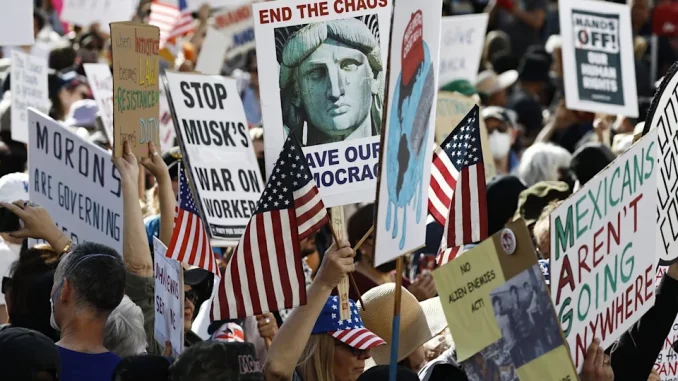
| Published July 17, 2025
On July 17, 2025, left-wing activist groups staged over 1,600 coordinated protests across the United States under the banner “Good Trouble Lives On,” invoking the legacy of the late Congressman John Lewis. While billed as a tribute to civil rights and democracy, the events were unmistakably political—targeting President Donald Trump and conservative policies on immigration, healthcare, and national security.
Behind the slogans and symbolism lies a deeper agenda: to galvanize opposition to voter-supported reforms by framing them as threats to freedom. But for millions of Americans who believe in secure borders, strong leadership, and constitutional values, these protests represent not justice—but division disguised as virtue.
🗞️ Context & Overview
-
What happened: On July 17, 2025, over 1,600 “Good Trouble Lives On” protests unfolded in all 50 states—ranging from small town rallies to major events in Chicago, Houston, Portland, and Washington D.C.—aligned with the fifth anniversary of civil rights icon John Lewis’s death
-
Organizers: A coalition of left‑leaning groups—like the ACLU, Public Citizen, League of Women Voters, Black Voters Matter, and those behind “No Kings” and “Hands Off!” protests—penned it as a protest against Trump-era policies on immigration, healthcare, voting rights, and public funding
📊 Scale & Coordination
-
Nationwide coordination: With over 56,000 RSVPs for 1,500+ events by July 11, these protests were meticulously organized and framed with serious messaging, promoting a unified national narrative
-
Sharp opposition: The messaging points at a sweeping critique of President Trump—accusing his administration of mass deportations, Medicaid cuts, defunding public broadcasting, rolling back civil and voting rights
📌 Coverage & Critique
-
Media portrayal: Major outlets like Newsweek, USA Today, Firstpost, and The Guardian praised the protests as peaceful and meaningful tributes to Lewis’s legacy
-
Skepticism on impact: Critics argue this orchestrated grand-scale activism risks becoming performative. Even Fox News revealed that “Crowds on Demand” was offered $20 million to mobilize protestors—but the organizer declined, believing the effort would be “ineffective” and detrimental to its credibility
🏛️ Right‑Wing Perspective
-
Symbolism over substance?
Referencing John Lewis’s legacy carries moral power. But modern activists risk reducing his “necessary” civil disobedience to politicized street theater rooted in partisanship—not principled unity. -
Top‑down mobilization vs. grassroots passion:
Securing RSVPs doesn’t guarantee genuine community engagement. Massive numbers don’t equal deep-rooted conviction, especially when campaigns use demand-driven tools to inflate appearance. -
Policy criticisms—left‑leaning caricatures:
Protests often portray Trump’s policies as authoritarian overreach. But policy makers on the right argue those measures reflect voter-mandated action—aimed at border security, fiscal prudence, and responsive governance -
Public mandate matters:
As the White House stated, Trump commands the support of nearly 80 million Americans—whose voice matters too. National protests, however large, don’t necessarily represent the nuanced majority view.
⚖️ Implications:
-
Erosion of Civil Discourse
By labeling all Trump-era policies as threats to democracy, these protests contribute to a dangerous narrative that equates political disagreement with oppression—undermining healthy debate and demonizing millions of voters. -
Weaponization of Civil Rights Legacy
Invoking John Lewis’s name to rally against current policies risks politicizing his legacy. Instead of uniting Americans around shared principles of justice, it turns his memory into a partisan tool. -
Astroturf Over Grassroots?
The scale and coordination of these protests suggest top-down organizing, not organic civic engagement. When protests become PR events, they lose authenticity and invite skepticism about their true intent. -
Normalization of Mass Protest as a Political Weapon
As demonstrations become a routine response to legislative action, the left risks conditioning the public to expect mob pressure over constitutional processes—setting a precedent that could backfire long-term. -
Media Amplification of One-Sided Narratives
Legacy media coverage continues to lionize progressive causes while casting conservative perspectives as regressive. This further polarizes the public and damages trust in journalism. -
Potential Distraction from Real Issues
While rallies dominate headlines, they often distract from real solutions—like border enforcement, economic revitalization, and restoring public trust in institutions.
 Overall Takeaway:
Overall Takeaway:
While the “Good Trouble Lives On” protests may appear as a noble tribute to the late John Lewis, they ultimately serve as a highly coordinated partisan display aimed at undermining the will of millions of Americans who continue to support President Trump’s policies. Cloaking left-wing activism in civil rights rhetoric dilutes the seriousness of true historic struggles and turns national discourse into political theater.
Instead of marching in protest of voter-backed reforms on immigration, healthcare, and national security, critics of the Trump administration should engage through the democratic process—not by rewriting history or inflaming division. Real “good trouble” uplifts the nation through integrity and reform—not by vilifying half the country for casting a ballot differently.





Be the first to comment